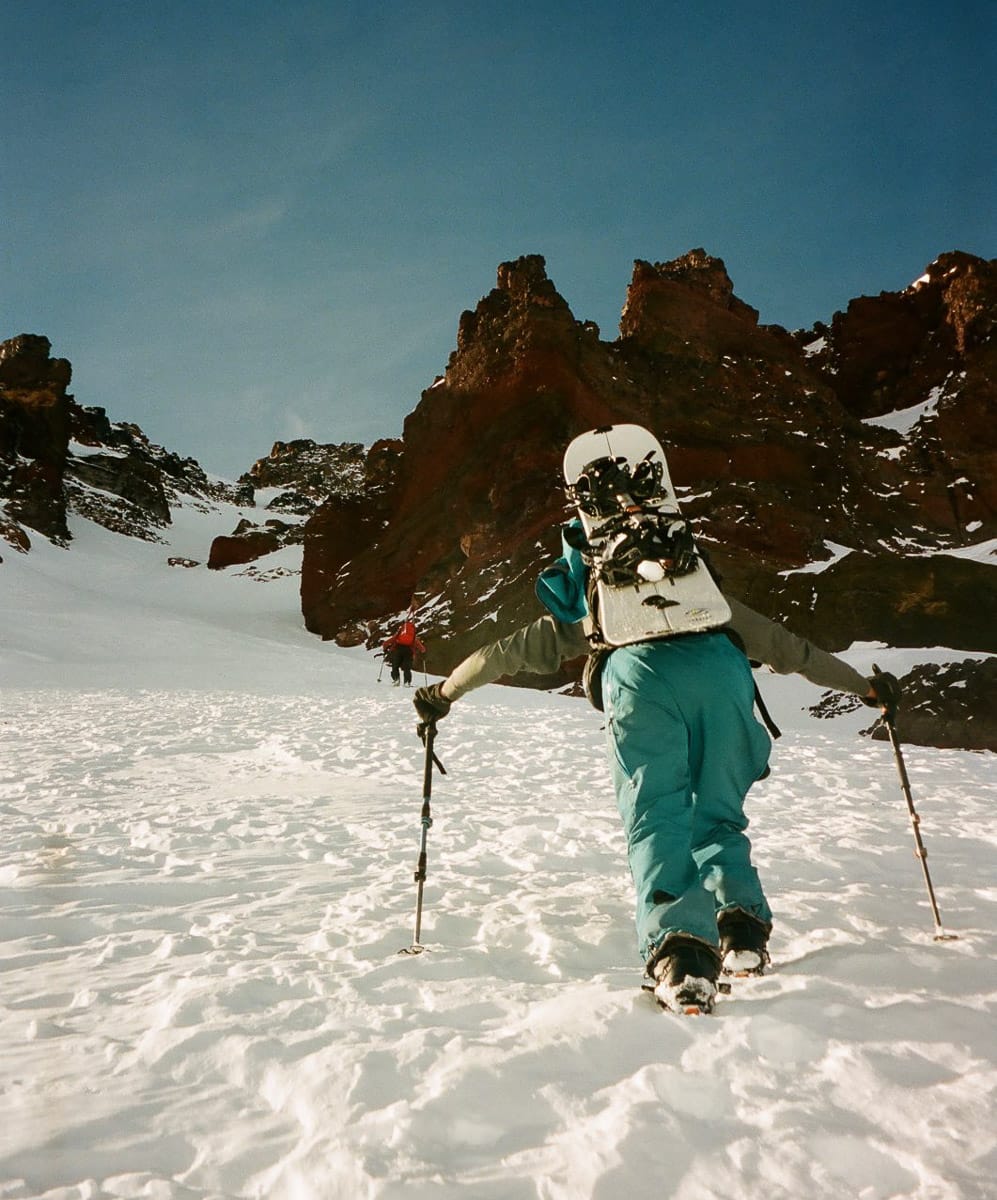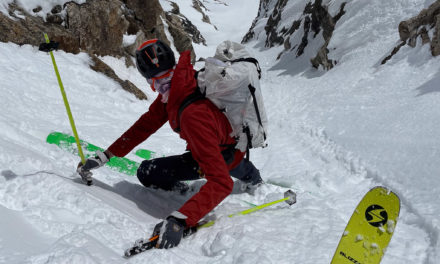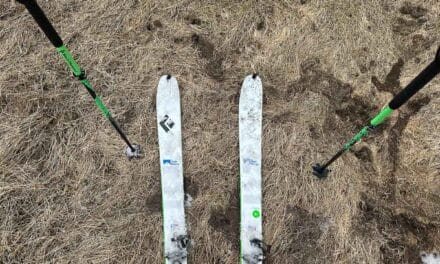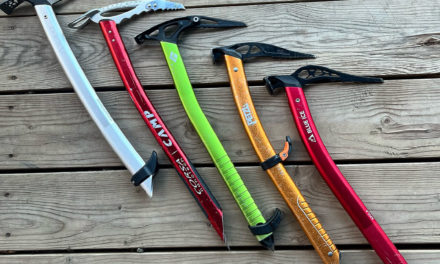This article is about crampons for splitboarders and two individuals’ experiences on their respective paths. Because we delve into crampons, which go on the feet, we’ll also discuss hardboots and softboots. However, there’s no going to the mat here. We’ll leave the debate over splitboarding footwear for another time.
On one hand, we have Daniel Crist, a dedicated SLC-based splitboarder (and hardbooter) who is nearing the completion of his AMGA Ski Guide certification as a splitboarder. On the other hand, we have Matt Colton, a somewhat itinerant splitboarder based out of Bend, sometimes, and most times, chasing snow across longitudes and latitudes. Both Daniel and Matt are happy splitboarders. Dan’s a happy hardbooter. Matt’s a happy softbooter. Both use crampons.
The Story Genesis
I had an experience in early March where a group of us moved through semi-exposed terrain. The lone splitboarder on the tour, by far the fittest and most skilled at their descending craft, was a softbooter. I think it’s fair to say he wasn’t exactly psyched with our position.
I’m of the school that even in mid-winter if I’m entering the alpine and its unknown terrain, I often throw a pair of lightweight all-aluminum crampons in my pack. What I may gain in mental security and more efficient mountain travel should I need these sharps is worth the extra weight. As a non-snowboarder, I’ve often marveled at how efficient softbooters are when booting a couloir (with or without snowplates), or scrambling. That said, there comes a time when crampons make sense. Had the softbooter I was with in March donned crampons and felt comfortable using them, I’m certain he would have danced through the moves. Ultimately, he would have been less stressed.
Let’s start with Matt, who, no surprise, wasn’t in Bend when I reached him; he had just emerged from a five-day jaunt in the Eastern Sierra. For those interested, his go-to boot is the K2 Aspect, which features a BOA closure inner and a lace-up outer. The boots have a rear welt to accommodate a crampon’s heel lever but lack a suitable toe welt for a toe bail. In this case, Matt uses a hybrid crampon: these secure with a proper toe strap and a heel lever.
Matt has two sets of crampons, one an all-steel 12-point affair, the other a lighter set with an aluminum rear and steel front. “I come from a freestyle background, and from skateboarding, I don’t have a climbing background. A lot of people who are softbooting and getting into splitboarding have my background.”
“On this five-day camping trip in the Sierra, I carried the heavier full steel crampons because I was going out with people comfortable moving in more exposed terrain than I am. If I think I’m going to be leaning in and relying on my crampons for a significant portion of time, I opt for the heavier 12-point crampons. I also think these help add rigidity to my snowboard boots. If I were keener on riding big objectives, requiring more technical work to ascend and descend, I’d move to a hardboot setup.”
This is not to say Colton is not on top of his game. He is. He knows what he likes and seeks it out: long, flowy ski pitches at speed. “I’m not that into hop-turning.”
Colton says he prefers lines he can ski top-down, which doesn’t necessarily require a bottom-up approach. “I can approach a line, for example, by going around the back side and skinning most of the way, and avoid any potential objective danger on the ascent. This strategy also allows me to remain in a softboot system and have the crampons as one tool for security.
Before we pivot away from the softboot-and-crampons perspective, Colton makes a key point. Oftentimes, softbooters are grouped with skiers, who, by default, are in hard shells. If the terrain warrants steep booting, kicking steps in ski boots without crampons is often secure and easy. “For me, moving through a little technical section in my softboots, it might take five minutes to put my crampons on, move across, and then remove them. My partners all get that.”
Crist embraces a different mode regarding ascending and descending—he’s moved to hardboots. In part, his transition stems from the terrain he found himself ascending.
“I had a pair of DC snowboarding boots that I brought out to Estes years ago. I rolled with those for a handful of seasons until they weren’t going to cut it anymore,” said Crist. “I sought a boot I could climb confidently in and still get the ride sense that I still wanted on the downhill.”
Crist added that he used a classic strap-on crampon with the DC boots. “As soon as the soles bent and collapsed enough, the crampon would loosen or fall off. I remember putting an absurd amount of ski straps across the forefoot of my boot to have these things stick to my feet. Obviously, we can all see where that would go.”
Next in his boot arsenal was a Fitwell snowboard boot out of Italy—think of it resembling a beefy mountaineering boot: proper heel welt and a somewhat streamlined toe box for more precise foot placements while climbing.
As Crist progressed, he sought steeper snow, alpine, and water ice. Eventually, the security Crist demanded while ascending led him to a hardshell snowboard boot, the Phantom Industries Slipper. With a hardshell, Crist could seek more technical ascents for his mountain journeys.
“It became clear that as I pushed the type of climbing to get to a certain descent, at some point, it made sense to pivot into some hard boots because they’re just more reliable and secure when cramponing. I gained efficiency on the uphill in more technical terrain, and I could climb harder, especially when mixed climbing with a pair of crampons on my feet; I could fully weight them. And with the hardboot, I’ve got ample cuff rotation, which assists with the climbing, too,” said Crist.
Where does this leave us? These are simply thoughts and ideas about being safer and moving effectively in the hills. I suppose, by nature, ski and splitboard tourists push boundaries. If we meander in the mountains, we are bound, at some point, to move into dicier terrain that may necessitate the use, for example, of crampons. For just over 200g, less than half a pound, having some crampon security in the rucksack, for the potentiality of having them on your feet, softboot or hardboot, can be a good overall strategy.
There we have it. Two perspectives. Two types of boots for specific cramponing/ascent applications. And one love.







Fellow splitboarder here, based in WA. I mostly tour in hardboots but use softboots occasionally. With my hardboots I only bring crampons in the springtime, but with the sofboots I almost always bring some time of crampon. My favorite for these is the skeats mountain cleats which work great for ski or boot emergency use, take up minimal space in my pack, and include ski straps I can use as part of my repair kit. True ski and boot crampons vastly outperform them in my experience but they have saved my bacon a few times.